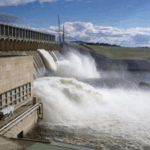
Farmers and communities living along the White Volta River basin are preparing for the annual spillage of the Bagre and Kompienga Dams in Burkina Faso, which is scheduled to begin on Monday, August 25, 2025.
The short notice has sparked fear and anxiety among the affected populations, who are worried about the potential destruction of their crops and farmlands.
Mr. Samuel Azure, a peasant farmer in the Binduri District, expressed his concerns, saying, “The notice is too short. We received the information only a few days ago.
Initially, the spillage was scheduled for August 27, but suddenly the date was changed to August 25, and we got the information just last Saturday.”
Many farmers in the area have not harvested their
crops yet, and the sudden spillage could destroy their produce, exacerbating their economic hardship.
“Most of our farmers who planted maize and naara (early millet) are going to be adversely affected because they have not finished harvesting”, he said.
He added that “If the destruction is severe, which we anticipate since our rivers are already full from recent rains, it could pose food insecurity to many families,” he said.
SONABEL, the power-producing company of Burkina Faso and manager of the Bagre and Kompienga Dams, announced on Saturday that the spillage would begin two days earlier than originally scheduled (Wednesday, August 27, 2025) due to a rapid rise in water levels.
A statement issued in Ghana by the Water Resources Commission indicated that as of Saturday, August 23, 2025, the Bagre Dam had reached 90.24 per cent of its filling capacity, corresponding to a water level of 234.27 metres.
just 0.73 below its maximum retention level.
Similarly, the Kompienga Dam is at 177.90 metres with a filling rate of 79.36 per cent and 2,10 metres below its normal retention level.
Over the years, the annual spillage of the Bagre Dam has caused widespread flooding in downstream communities in Ghana, particularly in the Upper East and North East Regions, destroying farmlands, killing livestock, damaging property, and, in some cases, leading to loss of lives.
In the Upper East Region, the spillage of water from the two dams usually causes the White Volta and its tributaries to overflow their banks, affecting several communities in districts including Binduri, Bawku West, Garu, Bawku Municipal, Tempane, Talensi, and Nabdam.
Farmers cultivating rice, maize, millet, and vegetables along the White Volta are typically the most severely affected, with several hectares of farmland submerged, displacing families, disrupting livelihoods, erasing investments, and exacerbating food insecurity among vulnerable communities.
Mr Jesse Kazapoe, Head of the White Volta Basin of the Water Resources Commission, allayed the fears of farmers and residents, advising communities to move to higher grounds for safety and to avoid farming along the riverbanks during the period.
“We have sent out information, educating the farmers to move to high grounds so we can prevent loss of lives, but we cannot guarantee that food crops will not be lost since some farmers are still harvesting,” he said.
Mr Isaac Pabia, the Upper East Regional Focal Person and National Secretary of the Peasant Farmers Association of Ghana (PFAG), noted that the annual losses caused by the spillage of the Bagre Dam were unacceptable and advised farmers to avoid farming close to the banks of the White Volta River.
“Some of our farmers have already evacuated, but we need to enforce buffers along water bodies so that farmers will not farm so close to the rivers to
avoid having their crops flooded every year,” he said.
Mr Christopher Beokena, the Upper East Regional Deputy Director of the National Disaster Management Organisation (NADMO) in charge of Administration, noted that all district directors had been tasked to sensitise farmers on the impending spillage and the precautionary measures.
“As we speak, some farmers have started harvesting even though some of their crops are not mature and we will be monitoring the issue and providing assistance”, he said.